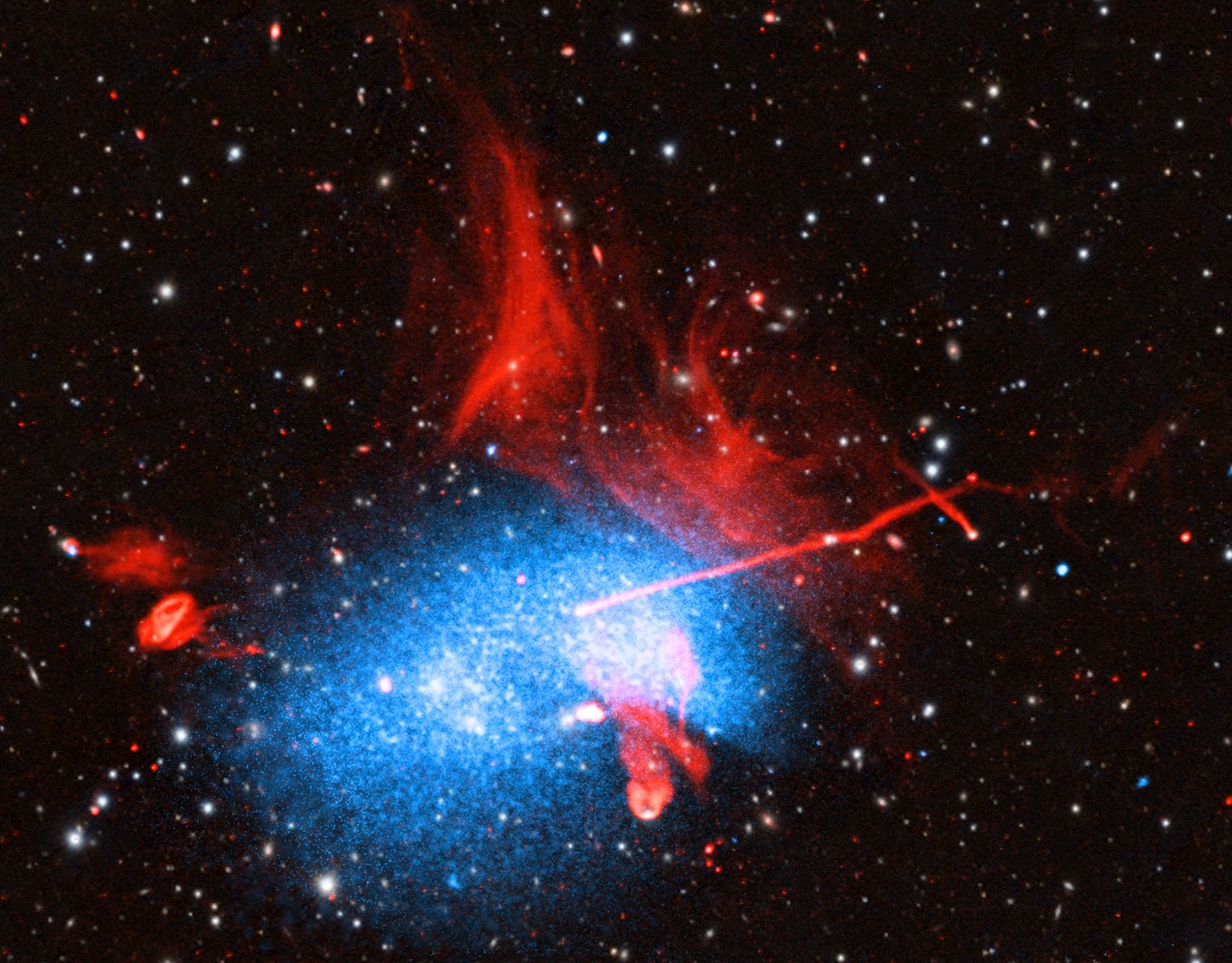Astronomers have recorded a remarkable, in-progress collision between no less than three galaxy clusters. Data from NASA’s Chandra X-Ray Observatory, European Space Agency’s (ESA’s) XMM-Newton, and a triad of radio telescopes are assisting astronomers in understanding what is taking place in this chaotic scene.

Galaxy cluster Abell 2256. Image Credit: X-Ray: Chandra: NASA/CXC/University of Bologna/K. Rajpurohit et al.; XMM-Newton: ESA/XMM-Newton/University of Bologna/K. Rajpurohit et al. Radio: LOFAR: LOFAR/ASTRON; GMRT: NCRA/TIFR/GMRT; VLA: NSF/NRAO/VLA; Optical/IR: Pan-STARRS.
Collisions and mergers are the primary way galaxy clusters form into the massive structures observed today and also function as the universe's largest particle accelerators. The developing galaxy cluster, Abell 2256, located 780 million light-years from Earth, is seen in a composite image combining X-ray data from Chandra and XMM (in blue) with radio data from various observatories (in red) and infrared and optical data from Pan-STARRs (in pale yellow and white).
Astronomers studying Abell 2256 are trying to understand the cause of its unusual structure. Each telescope provides a different aspect of the story, as galaxy clusters are some of the largest objects in the universe, made up of hundreds or even thousands of individual galaxies.
Furthermore, they comprise huge reservoirs of superheated gas with temperatures of several million degrees Fahrenheit. Only X-Ray telescopes such as XMM and Chandra can observe this hot gas. A labeled version of the figure illustrates gas from two of the galaxy clusters, with the third merged too closely to differentiate from the others.
This system’s radio emission arises from an even more multifaceted set of sources. The first pertains to the galaxies themselves, wherein the radio signal is produced by particles exploding as jets from supermassive black holes at their centers.
These jets shoot either into space in straight and narrow lines (those marked “C” and “I” in the annotated image, employing the astronomer’s naming system) or slowed down as the jets interact with gas they bump into, forming intricate shapes and filaments (“A,” “B,” and “F”).
Source F comprises three sources, all formed by a black hole in a galaxy lining up with the left-most source of this trio.
Radio waves are also emanating from enormous filamentary structures (labeled “relic”), typically situated to the north of the radiowave-emitting galaxies, probably produced when the collision generated shock waves and affected particles in the gas across more than two million light-years.
An article examining this structure was published by Kamlesh Rajpurohit from the University of Bologna in Italy in the March 2022 issue of The Astrophysical Journal. This is Paper I in an in-progress series investigating various aspects of this colliding galaxy cluster system. This article is available online.
Lastly, there is a “halo” of radio emission situated close to the center of the collision. Because this halo intersects with the X-Ray emission and is blurrier than the filamentary structure and the galaxies, another radio image has been generated to highlight the feeble radio emission.
The paper headed by Rajpurohit was recently published in the journal Astronomy and Astrophysics. It showcases a model where the halo emission may be created by the reacceleration of particles by quick variations in the density and temperature of the gas as the collision and joining of the clusters progress.
This model, however, is incapable of elucidating all the features of the radio data, emphasizing the need for the further theoretical study of this and analogous objects.
Paper III by Rajpurohit and co-workers will explore the galaxies creating radio waves in Abell 2256. This cluster comprises a remarkably huge number of such galaxies, perhaps because the collision and merger are activating the growth of supermassive black holes and resulting eruptions.
More particulars concerning the LOFAR image of Abell 2256 will be provided in a forthcoming article by Erik Osinga.
Journal References
Rajpurohit, K., et al. (2022) Deep low-frequency radio observations of Abell 2256. Astronomy & Astrophysics. doi.org/ 10.1051/0004-6361/202244925.
Rajpurohit, K., et al. (2022) Deep Low-frequency Radio Observations of A2256. I. The Filamentary Radio Relic. The Astrophysical Journal. doi.org/10.3847/1538-4357/ac4708.